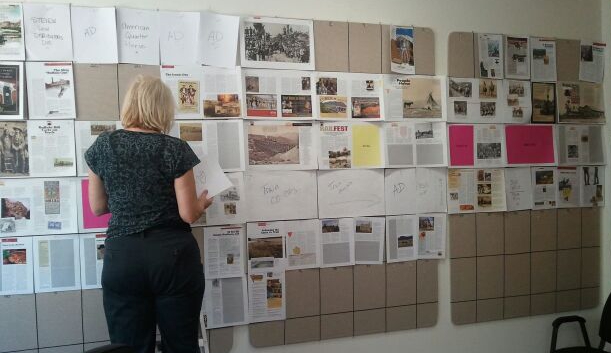Awhile ago, a colleague asked me for help in planning out a long storytelling program. I suggested that she write down each story she was contemplating on a sticky note and place them all on a wall so she could get a sense of what she had, and how they all connected to each other. Then, she could move them around and find the best sequence and “fit” for her event. Come to find out, I believe the idea was in good company.
This week, I drove up to Cave Creek, to visit with my long-time friend, Bob “Boze” Bell, Executive Editor of True West Magazine. Bob had spoken about True West’s “Wall”, a process they have begun using to assist them in decision making regarding the layout of the magazine. We’ve all done “storyboarding” to plot out the sequence of a single story. This is similar…but on a much larger scale.
The Magazine is published once a month, with anywhere from 96-136 pages. Previously, all staff members would gather around the computer and go through each page (or two-page spread) one at a time. They would make comments about what they liked or thought needed improvement, but they only saw each piece separately.
 Things changed a few months ago. Their Publisher, Ken Amorosano suggested they put ALL the pages up on the wall in their conference room, 97 pages, all in succession. The result: “The whole is much larger than the sum of its parts.”
Things changed a few months ago. Their Publisher, Ken Amorosano suggested they put ALL the pages up on the wall in their conference room, 97 pages, all in succession. The result: “The whole is much larger than the sum of its parts.”
Now, all staff members can view not only each story (and ad) individually, but they can see it in sequence, cover to cover. They can see the flow, how each story relates to the other; do the ads clash, or fight for attention with each other, or article content. They can look at colors, fonts, design and consistency throughout the entire magazine. “It’s changed the way we make decisions,” said Bell. “It has given us a whole new perspective on each issue and the publishing process.”
On the way home, I began to think more about expanding on this process for storytelling, and for organizing a long program. My original thought and suggestion to my colleague was to merely write down the title of each story. If we are really conscientious about our work, we must ask ourselves: who is our audience; what do they want; what do we want/hope that they will feel at the end of each story; at the end of the program; what stories will best accomplish all of this…AND what sequence? This “StoryWall” concept might be just the ticket!
Then I remembered that Sean Buvala had recently shared with me that he had gone to present a program in Canada several months ago. After arriving, and based on new information he had received, he became concerned that some material should be changed. So, that night, he used index card sized sticky notes on the wall to help make decisions about the content and order of his program. Guess I’m still in good company!
So, here are my thoughts on the structure of such a StoryWall:
Write down the following on a separate piece of paper or large sticky note (you can get big ones at the office supply store):
-
Story title
-
Length of the story
-
Genre of story – personal, fairytale, folktale, etc.
-
Themes in the story – triumph, justice, love, danger, etc.
-
Tenor of the story – is it loud, funny, sad, outrageous, introspective, etc.
-
Emotions evoked in the story
-
The Most Important Thing in the story (Doug Lipman’s MIT)
Put all the pieces up on the wall and begin the process. Is there a theme to the sequence? How would each flow from one to the next? Do you want three long stories in a row, or want to break up the time progression? Do you want to purposefully “shock” your audience by changing the tenor in a drastic way?
Play around with it a bit. You may need to try several different combinations and sequences. Walk away from the wall and do something else. Take your mind away from it for awhile. Then come back and see if you feel the same about the order.
Oh yes, one more thing. Once you have made a decision on the order and progression…PRACTICE IT!
©Mark Goldman 2012
Top of page